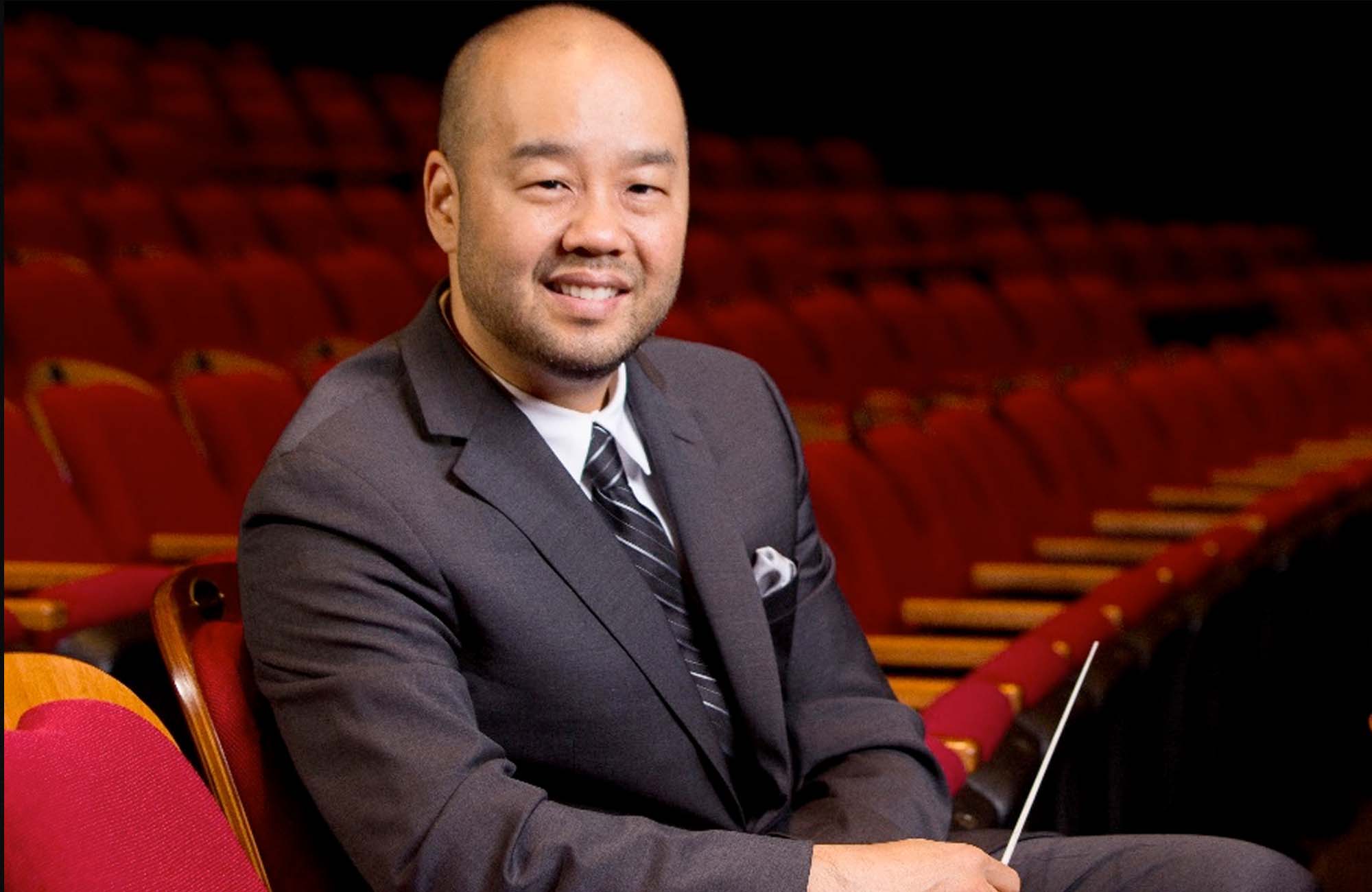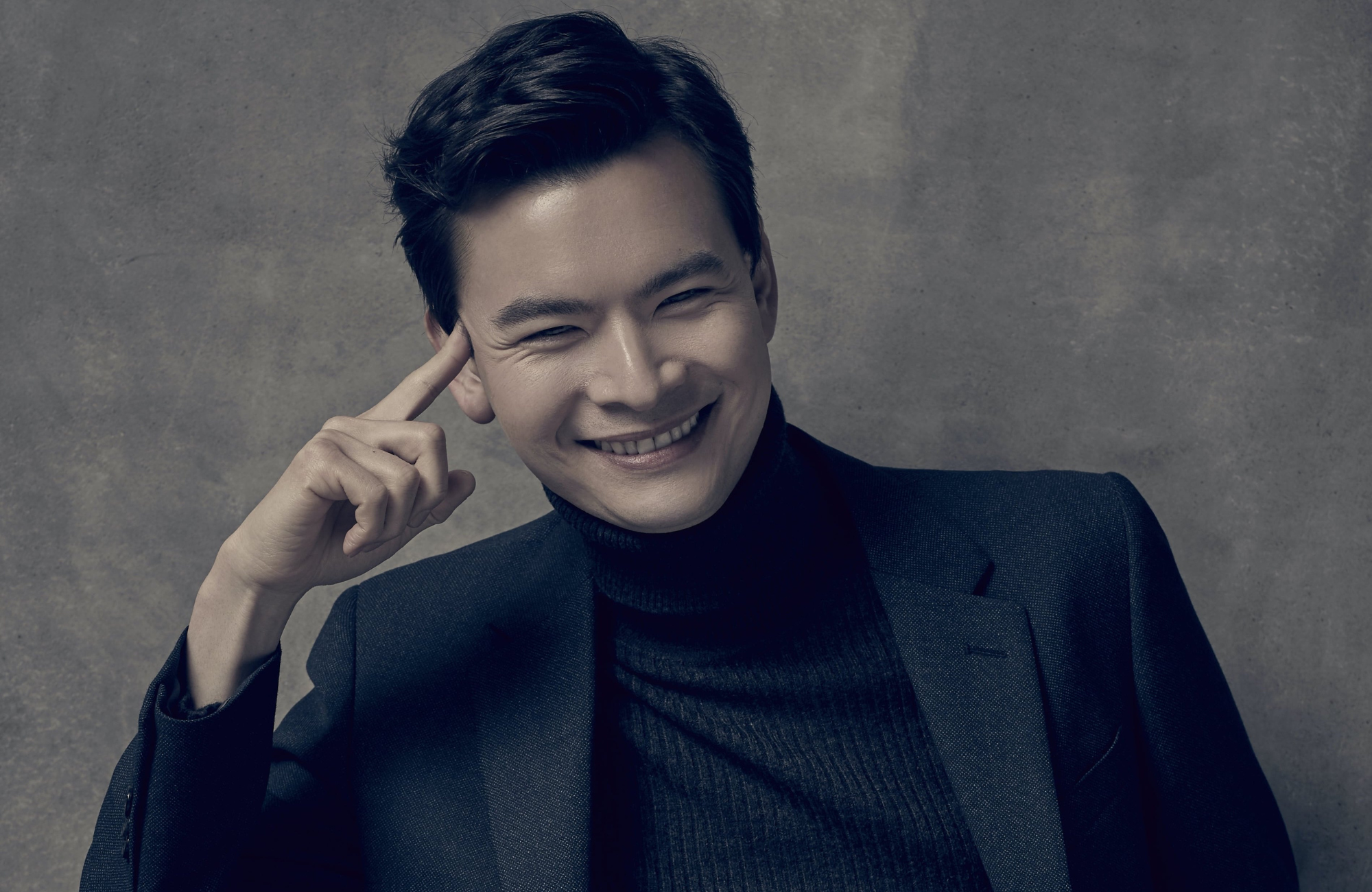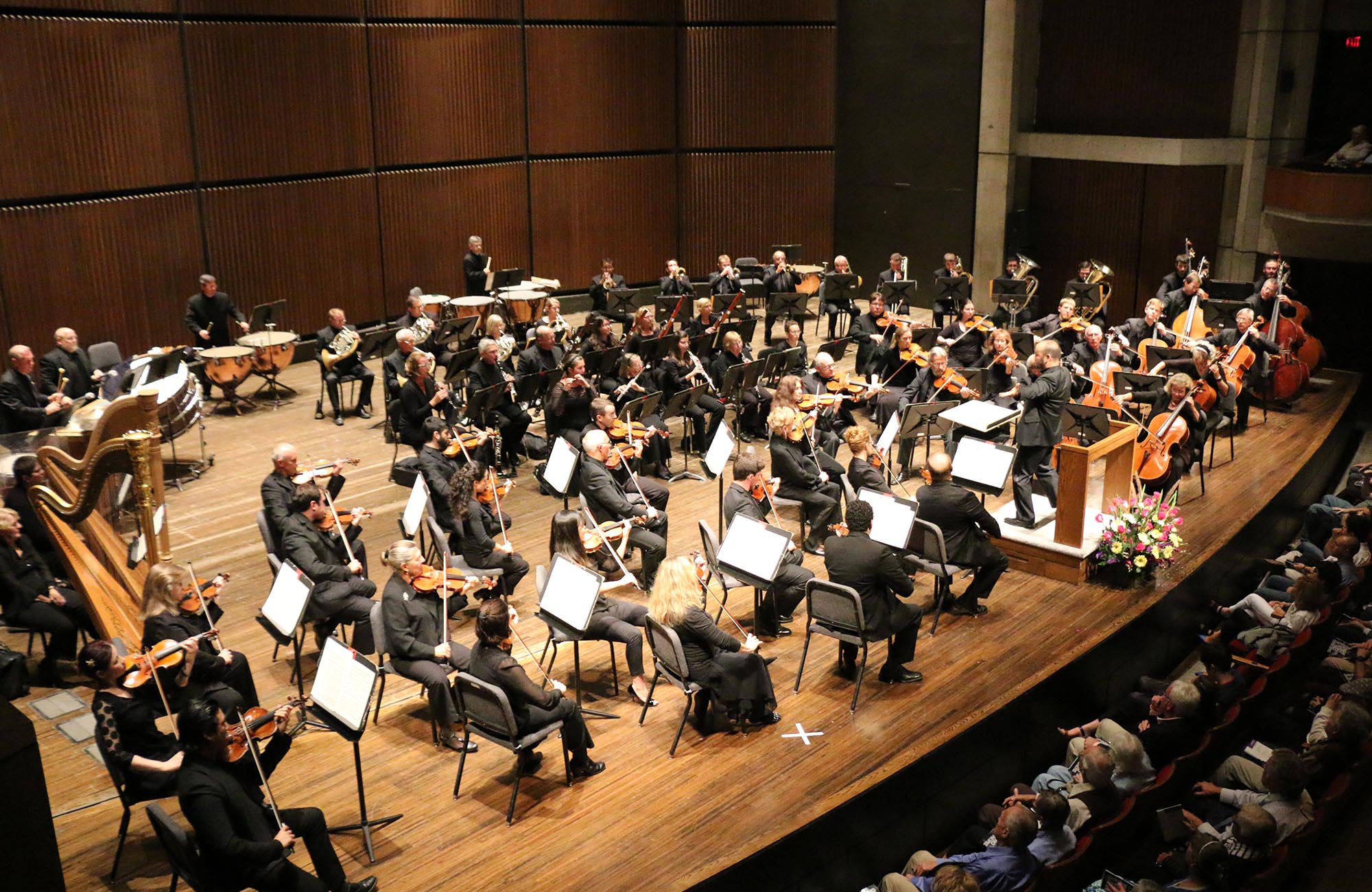PROGRAM
Performed on April 22 , 2017 at Course Hinds Theater
Lawrence Loh conducting
Hector Berlioz
Béatrice and Bénédict: Overture
Performed on September 27, 2014 at Course Hinds Theater
Lawrence Loh, conducting
Michael Torke
Javelin
Performed on September 27, 2014 at Course Hinds Theater
Stefan Jackiw, violin; Lawrence Loh conducting
Serge Prokofiev
Violin Concerto No.2, op.63, G minor
Performed on September 27, 2014 at Course Hinds Theater
Lianne Coble, soprano; Barbara Rearick, mezzo-soprano; Noah Baetge, tenor; Jeremy Galyon, bass; Lawrence Loh conducting
Ludwig van Beethoven
Symphony No.5, op.67, C minor
PROGRAM NOTES
Our first work tonight serves a double function, launching the 2014-15 season and welcoming Lawrence Loh as Music Director Designate of Symphoria. And what better piece for those purposes than Javelin? This eight-minute dazzler was composed in 1994 by Michael Torke (b. 1961) both to open the 1996 Olympics and to honor the 50th anniversary of the Atlanta Symphony Orchestra. As Loh puts it, it’s a “celebratory” piece with “lots of intricate rhythms” that “shows off all the sections of the orchestra.” It’s also a tremendously upbeat work. Its sparkling chatter explodes like champagne bubbles; and if its big tune ...
Our first work tonight serves a double function, launching the 2014-15 season and welcoming Lawrence Loh as Music Director Designate of Symphoria. And what better piece for those purposes than Javelin? This eight-minute dazzler was composed in 1994 by Michael Torke (b. 1961) both to open the 1996 Olympics and to honor the 50th anniversary of the Atlanta Symphony Orchestra. As Loh puts it, it’s a “celebratory” piece with “lots of intricate rhythms” that “shows off all the sections of the orchestra.” It’s also a tremendously upbeat work. Its sparkling chatter explodes like champagne bubbles; and if its big tune reminds you of Holst’s “Jupiter” filtered through ET—well, Torke readily admits the John Williams influence.
Javelin may serve a third function as well. Throughout the season, we’ll be highlighting “connections” of various sorts—and beginning the concert with Javelin and ending it with the Symphony No. 5 by Ludwig van Beethoven (1770-1827) points out some musical continuity over nearly two centuries. At first glance, perhaps, the two pieces seem radically different. The Torke is hip, up-to-date, with a strong dose of American minimalism and pop; the Beethoven is perhaps the most canonical monument of European classical music. Then, too, Torke avoids the kind of Big Statement we often associate with the Fifth. But both rely on what Loh calls “continuous propulsion.” More specifically, both make their points through the sophisticated way their short rhythmic ideas bounce around the orchestra. Both require absolute alertness from the orchestra—and total control from the conductor.
Thus, while the Fifth might seem like safe repertoire, it actually puts the players in what Loh calls a “vulnerable” position. Because of that “continuous propulsion” and that mosaic of rhythmic ideas, “everyone has to be on the same wavelength.” Any faltering will, as in Javelin, be immediately evident. So will any wavering of concentration. Although the Beethoven is in four movements (the third and fourth of which are connected), the composer, Loh points out, “gives us the tools to make a huge arc from the beginning of first movement to end of finale.” Only by sustaining the arc can it generate “maximum power.”
The Fifth is no easier for a conductor. You can play it “a million different ways,” says Loh, who points out that the challenges emerge at the very beginning with the fermatas at the end of the first phrases, the familiar da-da-da-DUUHs. “How do you handle them? Do you make a break after the fermata? Do you have orchestra hold it? How many bows do they take?” So if there are a million ways to play the Fifth, what can we expect tonight? No spoilers here—one advantage of live performances over recordings is that you never know what will happen. Given Loh’s emphasis on “continuous propulsion” and “maximum power,” though, it’s unlikely that tonight’s Fifth will lumber under the weight of the work’s tradition of monumentality.
The main work between the Torke and the Beethoven is the Violin Concerto No. 2 in G Minor, op. 63, by Sergei Prokofiev (1891-1953), which could hardly be more different. Composed in 1935, more or less contemporaneously with the composer’s Romeo and Juliet, it’s often considered one of Prokofiev’s gentler, more lyrical works, sharing the bitter-sweetness of the ballet. But it was written during a period of relentless travel, and our soloist Stefan Jackiw sees it as “very dark and menacing, even nihilistic. It’s in the standard three-movement form, but the outer movements make the performer and the listeners feel like they’re losing their sense of grounding and stability.” Examples? You might expect the concerto to begin with an orchestral statement—this one begins with the violin alone. More important, the opening material throws us off kilter rhythmically. Although the movement is written in 4/4 time, Jackiw points out that the “the building block of the entire movement”—the opening figure—“is in a group of five beats rather than three or four. And since there’s nothing else happening in the first measures—it’s just the solo violin playing this unaccompanied theme—there’s nothing to give us any frame of reference, to let us know where the strong beat actually is.” As a result, the concerto starts out with a “sense of instability and discomfort.” Jackiw doesn’t deny the “moments of incredible beauty and lyricism on the surface of the first movement” but notes that “if you listen to the underlying harmonies provided by the orchestra, there’s always a tinge of acidity or sourness, as if someone’s twisting the knife under the cover.” The movement ends with the opening material, decorated with orchestral pizzicatos “that sound almost like a guillotine falling. There’s something deadly about the idea that we went through this entire dramatic movement and ended up exactly where we started. All in vain—none of it had actually mattered.”
The finale creates a similar sense of dislocation. Jackiw compares it to Ravel’s La Valse (1920). “La Valse comments on the decadence and moral bankruptcy of that period in Europe. And it decays and degenerates into this crazy, out-of-control, perverse semblance of a waltz. Prokofiev’s third movement is a bit like that. Most of it has a kind of three-beat pattern reminiscent of a waltz, but it degenerates into a coda that alternates 5/8 and 7/8. These are rhythmically unstable and uncomfortable meters: it’s sort of like dancing around the stability of that waltz figure, but always short-changing us or adding an extra little bit. So again, we get the idea of something spiraling out of control and going into chaos.”
The central movement, more soothing, contains what Jackiw considers some of “the most beautiful, songful music ever written for the solo violin. It’s one of my favorite things to play. It’s so beautiful, at times so pure and innocent, which is all the more heartbreaking, considering the context, surrounded on either side by darkness. But even in the second movement there are periods where the lyricism disappears and you have stabs of an icy dagger, reminding you that everything is not okay.”
Loh sees the middle movement of Prokofiev as a lament—and the concerto is preceded tonight by another lament written nearly two centuries earlier: the Air from the Orchestral Suite No. 3 by Johann Sebastian Bach (1685-1750). This lament is more immediate and more personal for Symphoria and its audience, since it’s being played in memory of violist Chrissy Albright, who died suddenly in August. An appreciation of Chrissy and her contribution to our community can be found on page
Peter J. Rabinowitz
prabinowitz@ExperienceSymphoria.org
FEATURED ARTISTS

Described as bringing an “artisan storyteller’s sensitivity… shaping passages with clarity and power via beautifully sculpted dynamics… revealing orchestral character not seen or heard before” (Arts Knoxville) Lawrence Loh enjoys a dynamic career as a conductor of orchestras all over the world.
After an extensive two ...
Described as bringing an “artisan storyteller’s sensitivity… shaping passages with clarity and power via beautifully sculpted dynamics… revealing orchestral character not seen or heard before” (Arts Knoxville) Lawrence Loh enjoys a dynamic career as a conductor of orchestras all over the world.
After an extensive two year search, Lawrence Loh was recently named Music Director of the Waco Symphony Orchestra beginning in the Spring of 2024. Since 2015, he has served as Music Director of The Syracuse Orchestra (formerly called Symphoria), the successor to the Syracuse Symphony Orchestra. “The connection between the organization and its audience is one of the qualities that’s come to define Syracuse’s symphony as it wraps up its 10th season, a milestone that might have seemed impossible at the beginning,” (Syracuse.com) The Syracuse Orchestra and Lawrence Loh show that it is possible to create a “new, more sustainable artistic institution from the ground up.”
Appointed Assistant Conductor of the Pittsburgh Symphony in 2005, Mr Loh was quickly promoted to Associate and Resident Conductor within the first three years of working with the PSO. Always a favorite among Pittsburgh audiences, Loh returns frequently to his adopted city to conduct the PSO in a variety of concerts. Mr. Loh previously served as Music Director of the West Virginia Symphony Orchestra, Music Director of the Northeastern Pennsylvania Philharmonic, Artistic Director and Principal Conductor of the Syracuse Opera, Music Director of the Pittsburgh Youth Symphony Orchestra, Associate Conductor of the Dallas Symphony Orchestra, Associate Conductor of the Colorado Symphony Orchestra and Music Director of the Denver Young Artists Orchestra.
Mr. Loh’s recent guest conducting engagements include the San Francisco Symphony, Dallas Symphony, North Carolina Symphony, Baltimore Symphony, Sarasota Orchestra, Florida Orchestra, Pensacola Symphony, Atlanta Symphony, National Symphony, Detroit Symphony, San Diego Symphony, Seattle Symphony, National Symphony (D.C.), Utah Symphony, Rochester Philharmonic, Indianapolis Symphony, Calgary Philharmonic, Buffalo Philharmonic, Albany Symphony and the Cathedral Choral Society at the Washington National Cathedral. His summer appearances include the festivals of Grant Park, Boston University Tanglewood Institute, Tanglewood with the Boston Pops, Chautauqua, Sun Valley, Shippensburg, Bravo Vail Valley, the Kinhaven Music School and the Performing Arts Institute (PA).
As a self-described “Star Wars geek” and film music enthusiast, Loh has conducted numerous sold-out John Williams and film music tribute concerts. Part of his appeal is his ability to serve as both host and conductor. “It is his enthusiasm for Williams’ music and the films for which it was written that is Loh’s great strength in this program. A fan’s enthusiasm drives his performances in broad strokes and details and fills his speaking to the audience with irresistible appeal. He used no cue cards. One felt he could speak at filibuster length on Williams’ music.” (Pittsburgh Tribune)
Mr Loh has assisted John Williams on multiple occasions and has worked with a wide range of pops artists from Chris Botti and Ann Hampton Callaway to Jason Alexander and Idina Menzel. As one of the most requested conductors for conducting Films in Concert, Loh has led Black Panther, Star Wars (Episodes 4-6), Jaws, Nightmare Before Christmas, Jurassic Park, Casablanca, The Wizard of Oz and Singin’ in the Rain, among other film productions.
Lawrence Loh received his Artist Diploma in Orchestral Conducting from Yale, his Masters in Choral Conducting from Indiana University and his Bachelor of Arts from the University of Rochester. Lawrence Loh was born in southern California of Korean parentage and raised in Carlisle, Pennsylvania. He and his wife Jennifer have a son, Charlie, and a daughter, Hilary. Follow him on instagram @conductorlarryloh or Facebook at @lawrencelohconductor or visit his website, www.lawrenceloh.com

Stefan Jackiw is one of America’s foremost violinists, captivating audiences with playing that combines poetry and purity with impeccable technique. Hailed for playing of “uncommon musical substance” that is “striking for its intelligence and sensitivity” (Boston Globe), Jackiw has appeared as a soloist with the Boston, ...
Stefan Jackiw is one of America’s foremost violinists, captivating audiences with playing that combines poetry and purity with impeccable technique. Hailed for playing of “uncommon musical substance” that is “striking for its intelligence and sensitivity” (Boston Globe), Jackiw has appeared as a soloist with the Boston, Chicago, Cleveland, New York, Philadelphia, and San Francisco symphony orchestras, among others.
In the 2025–26 season, Stefan Jackiw returns to the Pittsburgh Symphony for Korngold’s Concerto, the Baltimore Symphony for Beethoven’s Triple Concerto alongside Inon Barnatan and Hayoung Choi, conducted by Jonathan Heyward, and the Indianapolis Symphony for Berg’s Violin Concerto. He launches the Austin Symphony’s season with Prokofiev’s Violin Concerto No. 2, which he also performs later with the Vancouver Symphony. Jackiw joins the Seoul Philharmonic and Mei-Ann Chen for Bruch’s Scottish Fantasy. In winter 2026, he opens the Laguna Beach Music Festival with three consecutive concerts featuring a varied repertoire, including Janáček’s Kreutzer Sonata. He also performs Dvořák’s Concerto with the Kansas City Symphony.
Jackiw is set to make his debut at London’s iconic Southbank Centre in a highly anticipated special trio project with cellist Alisa Weilerstein and pianist Inon Barnatan. He continues touring with Junction Trio with engagements at Chamber Music Sedona, Sanford-Hill Piano Series, Noe Music, Caramoor, Jacksonville Symphony, and additional dates to be announced. As a recitalist, he returns to Montclair State University, Denver Friends of Chamber Music, Harvard University, Friends of Music Sleepy Hollow, and The Rockefeller University, with additional performances to be announced.
Jackiw’s 2024-25 season highlights include performances with the Cleveland Orchestra under Santtu-Matias Rouvali, National Symphony Orchestra of Ireland, Suwon Philharmonic, Pasadena Symphony, The Florida Orchestra, Erie Philharmonic and the Jacksonville Symphony. He continued touring with Junction Trio, returning to the 92NY stage with a program including the world premiere of a new work by John Zorn and performing at Rockefeller University.
Jackiw opened his 2023-24 season returning to the New York Philharmonic to perform the Barber Concerto with Jaap van Zweden. His season also included a quadruple World Premiere of new works at Roulette, performances with the Taiwan Philharmonic, China National Symphony, and the Junction Trio’s highly praised debut at Carnegie Hall.
Jackiw tours frequently with his musical partners, pianist Conrad Tao and cellist Jay Campbell, as part of the Junction Trio. In 2021, Jackiw performed a new Violin concerto, written for him by Conrad Tao and premiered by the Atlanta Symphony and Baltimore Symphony. He also enjoys collaborating with pianist Jeremy Denk with whom he recorded the complete Ives Violin Sonatas on Nonesuch Records. The album was universally lauded by critics, with The New Yorker‘s Alex Ross naming Jackiw’s performance “a new standard.” In 2019, he recorded Beethoven’s Triple Concerto with Inon Barnatan, Alisa Weilerstein, Alan Gilbert and Academy St. Martin in the Fields. He has also premiered David Fulmer’s concerto Jauchzende Bögen with Matthias Pintscher and the Deutsche Kammerphilharmonie Bremen at the Heidelberger Frühling.
Jackiw has performed in numerous major festivals and concert halls around the world, including the Aspen Music Festival, Ravinia Festival, Caramoor International Music Festival, Schleswig-Holstein Music Festival, Lincoln Center’s Summer for the City Festival, the Philharmonie de Paris, Amsterdam’s Concertgebouw, the Celebrity Series of Boston, and the Washington Performing Arts Society.
Born to physicist parents of Korean and Ukrainian descent, Stefan Jackiw began playing the violin at the age of four. His teachers have included Zinaida Gilels, Michèle Auclair, and Donald Weilerstein. He holds a Bachelor of Arts from Harvard University, as well as an Artist Diploma from the New England Conservatory, and is the recipient of a prestigious Avery Fisher Career Grant. Jackiw plays a violin made by Domenico Montagnana “ex. Rossi” c. 1730, generously loaned by a private foundation. He lives in New York City.


